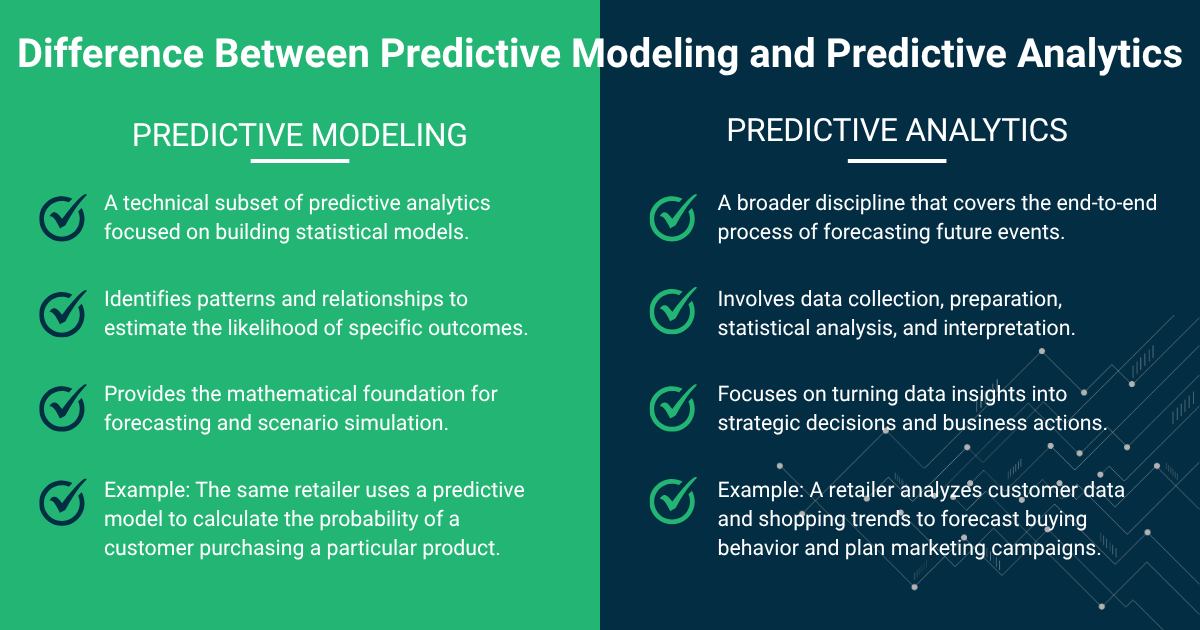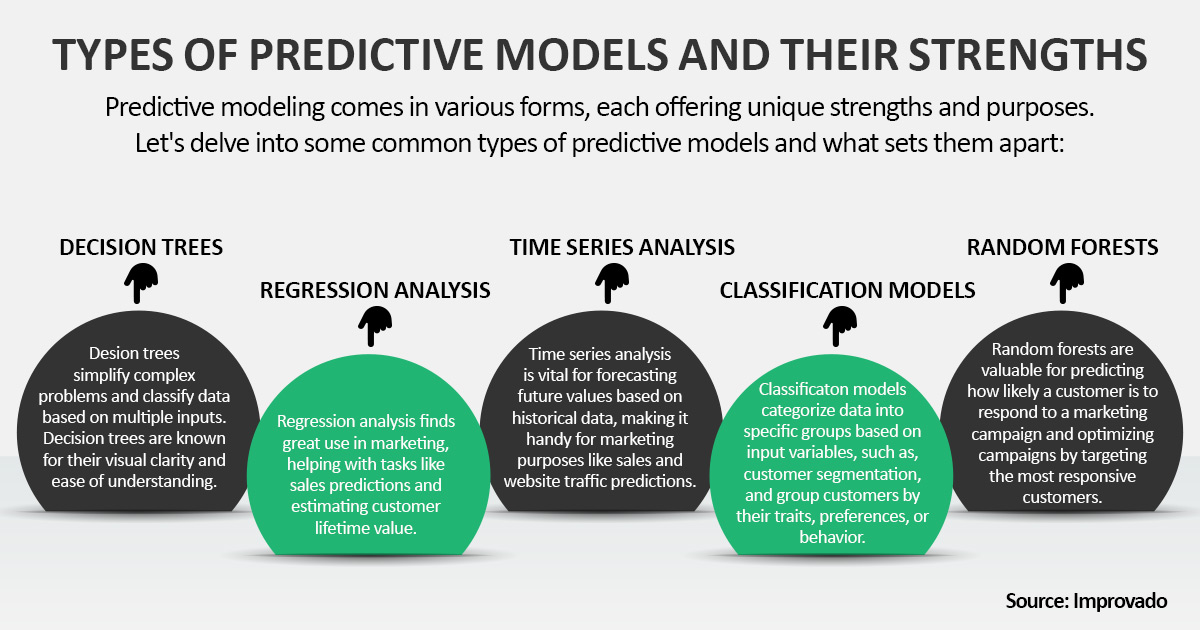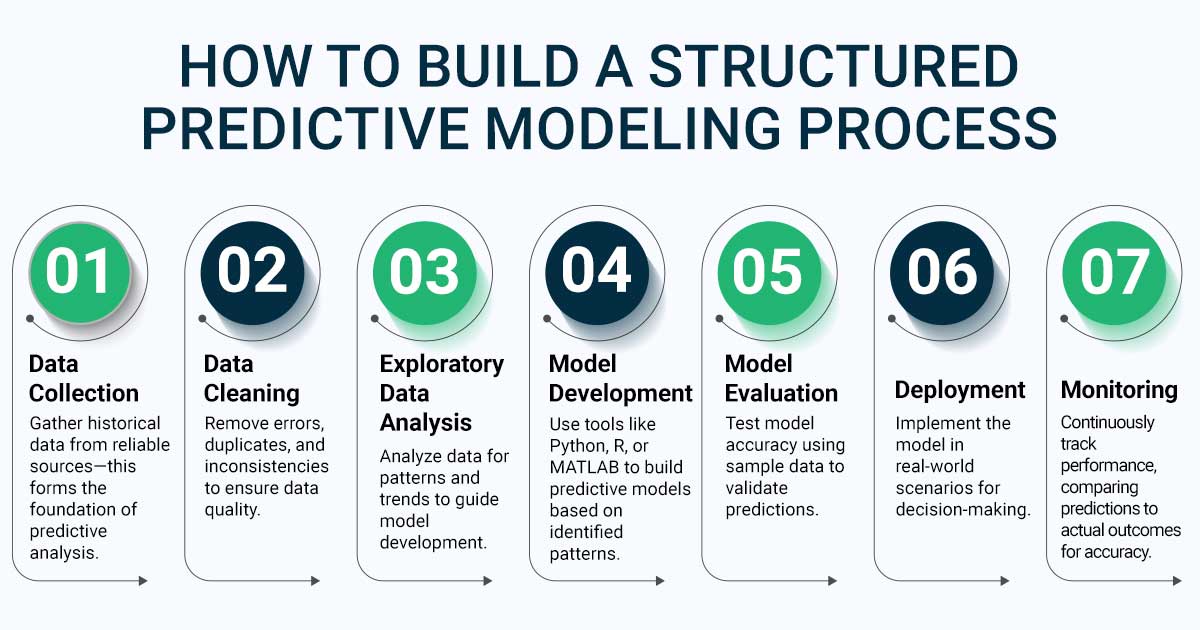
Quick Summary: In an era where reacting late can cost millions, predictive modeling has become the cornerstone of strategic decision-making. It transforms data into foresight, enabling leaders to anticipate risks, optimize performance, and act with confidence. But its real power lies in disciplined execution, where technology meets intent. This article examines how predictive modeling and solutions, such as predictive project management, are enabling organizations to transform uncertainty into measurable project success.
Why Business Leaders Can No Longer Ignore Predictive Modeling
In today’s hypercompetitive world, making decisions after the fact is a liability. Companies that survive and thrive are those that don’t just react to what happened but anticipate what’s coming. That’s where predictive modeling becomes a game-changer.
Consider these market realities:
- As of 2024, more than 55% of organizations reportedly use predictive tools in some capacity, with 48% citing improved accuracy and productivity as measurable outcomes.
- In 2024, analysts observed that automated predictive analytics is shifting from niche experiments to core business practices, becoming a foundational layer in BI/analytics stacks.
These numbers reflect a simple truth: predictive modeling is a strategic infrastructure. It is a lens that magnifies hidden risks, opportunity patterns, and trigger points before they become crises.
For example, imagine your support operation: Today, you review tickets and identify backlog. However, with a predictive model trained on historical escalations, staffing, ticket complexity, and seasonal load, you can forecast a ticket surge three days in advance, allowing you to prepare your team accordingly. This leads to a shorter lead time, transforming firefighting into proactive planning.
But what about project delivery—the space where business transformation is earned or lost? Projects remain one of the riskiest places in any organization. Project Management Works found that only 39% of all projects are delivered on time, on budget, and with the required features and functions. Businesses now use predictive modeling to foresee customer trends, manage supply chains, and optimize budgets. So why should project management, where missed insights can derail entire strategies, be left behind?
This article drills into that question. It demonstrates how we integrate predictive modeling from the realm of business functions into project management practice—transforming project oversight from reactive status tracking into forward-looking risk intelligence.
What is Predictive Modeling?
Predictive modeling is a mathematical technique that utilizes data and machine learning to forecast future events or outcomes by identifying patterns within a specified dataset. This is a crucial part of predictive analytics, which involves using both current and past data to predict what's likely to happen next.
So, what can predictive analytics and machine learning do for your projects? It applies statistical and machine-learning techniques to project data, that is, scope, schedule, cost, resources, dependencies, and stakeholder feedback, to estimate the likelihood of future outcomes. Typical outputs include probability of schedule slippage, forecast cost variance at completion, risk of scope churn, and early indicators of stakeholder misalignment.
So, why does predictive modelling matter now? Projects span distributed teams, intricate dependencies, and ongoing change. Traditional executive project dashboards show “what happened.” Predictive models reveal what’s likely next and which actions shift the outcome.

Top 6 Benefits of Predictive Modeling for Decision-Makers
Predictive modeling presents an array of benefits for you, the key decision-makers. It reveals critical insights that can drive strategic business decisions and add substantial value to an organization. Therefore, businesses are turning to predictive modeling to enhance their decision-making game. These models offer a wealth of advantages to various industries, including:
- Competitive Edge: Predictive modeling technology gives you, the tech leader, a competitive edge by allowing you to stay ahead of the curve.
- Customer Insight: They help in understanding and segmenting customers based on their behavior, preferences, and likelihood to engage or convert. This is critical for tailoring products and services.
- Risk Management: Predictive analytics identifies the risk, helps you react faster, while minimizing the harm these situations can cause. For example, managing the supply chain can be challenging, but predictive modeling makes it easier to manage. By examining data and analyzing transportation routes, inventory levels, and supplier performance, you can identify potential issues or disruptions that may arise.
- Enhanced Decision-Making: Predictive modeling can be used to improve existing products, ultimately boosting revenue. It provides a forward-looking perspective to make informed decisions. Instead of relying on intuition or past trends, you can depend on data-driven predictions to guide your strategic choices.
- Time and Cost Savings: Predictive models cut down on the time and expenses involved in making predictions.
- External Factors: These models can even predict external factors that might impact productivity, helping businesses prepare for what's ahead.
The benefits are clear. However, what truly proves the value of predictive modeling is how it’s being applied in the real world. Businesses across every industry are now leveraging it to modernize operations, refine their strategy, and accelerate digital transformation.
How Is Predictive Modeling Reshaping Business to Meet Digital Transformation Goals?
 The implementation of predictive modeling is not limited to technology projects. Today, several organizations are reevaluating how they manage their extensive collections of enterprise data. Dealing with vast and intricate data without modern, smart methods to organize and extract meaning from it can be a real challenge for businesses. That's why many tech leaders are making investments in predictive modeling technology. Let's take a look at some real-world examples of how different industries are using predictive modeling technology to streamline their operations and increase their bottom line:
The implementation of predictive modeling is not limited to technology projects. Today, several organizations are reevaluating how they manage their extensive collections of enterprise data. Dealing with vast and intricate data without modern, smart methods to organize and extract meaning from it can be a real challenge for businesses. That's why many tech leaders are making investments in predictive modeling technology. Let's take a look at some real-world examples of how different industries are using predictive modeling technology to streamline their operations and increase their bottom line:
- Retail: Retailers utilize prediction models and machine learning to plan their inventory, dynamically adjust prices, evaluate the success of promotional campaigns, and tailor personalized offers to customers.
- Healthcare: In the healthcare industry, machine learning prediction models enable healthcare providers to identify actions that enhance patient satisfaction, optimize resource utilization, and improve financial management, ultimately leading to better patient outcomes.
- Banking: Banks rely on predictive modeling to manage credit risk, capital, and liquidity, as well as to meet regulatory requirements. These models enhance security and compliance while also enabling banks to offer more personalized services, reduce customer churn, foster trust, and deliver exceptional customer experiences.
- Manufacturing: Predictive modeling focuses on anticipating maintenance needs and minimizing the costs associated with unexpected equipment failures. These models enable companies to enhance their performance, equipment efficiency, product quality, and ultimately, customer satisfaction.
As you gather more data, the insights you get from predictive modeling get better and more accurate. To make smarter decisions, don't just trust your instincts; let predictive modeling provide the insights you need to succeed. Seeing how predictive modeling drives measurable impact across industries naturally raises the following question: how can your organization achieve the same? The answer lies in following a few proven best practices that make implementation both effective and sustainable.
Turn foresight into your competitive edge. TrueProject empowers organizations to translate data into predictive intelligence, anticipating risks and ensuring flawless project delivery. Learn how TrueProject drives enterprise success.

How to Implement Predictive Modeling Successfully
Adopting predictive modeling is a cultural and technical shift. Success hinges on more than just buying software.
- Start with a Clear Business Objective: Begin with a specific, high-value problem, such as "reduce cost overruns in our IT portfolio by 15%."
- Ensure Data Quality and Accessibility: Invest in processes and platforms that improve the consistency and availability of your project data.
- Focus on Change Management: Introduce predictive insights as a solution for empowerment. Train teams to trust the data and use it for collaborative problem-solving.
- Choose the Right Solution for Your Ecosystem: Select a predictive platform that is powered by AI and integrates seamlessly with your existing PMO toolkit and is scalable across the organization.
- Iterate and Evolve: Start with a pilot program, demonstrate value, and gradually expand the use of predictive analytics to your entire project portfolio.
Implementing predictive modeling correctly can deliver incredible value. But even the most strategic approach isn’t without its challenges. Knowing what obstacles to expect helps organizations prepare, adapt, and build models that deliver lasting results.

What Are the Challenges of Predictive Modeling?
Predictive modeling is not without its challenges. One of the significant challenges of predictive modeling is that the technology heavily depends on the quality and accessibility of data. If the data is wrong or missing essential bits, it can negatively impact the accuracy of the predictions.
"Overfitting" is another drawback of predictive analytics and machine learning. This occurs when a model becomes overly reliant on the data it was trained on and performs well with that data, but struggles when it encounters new data. One additional disadvantage to consider is that predictive modeling technologies do not provide a clear explanation for their predictions. You might get a prediction, but it won't come with a user manual. Therefore, it is necessary to consider transparency and interpretability to understand how these predictions are made.
Yes, predictive modeling presents several challenges, including data dependency, model bias, and interpretability. But when executed with discipline and context, it brings unparalleled visibility into business performance and outcomes. That’s why more organizations are now applying predictive modeling to project management to anticipate risks before they impact outcomes.
See what your data’s been missing. TrueProject turns uncertainty into foresight, helping you predict risks, make confident decisions, and deliver results that matter. See how TrueProject enables you to lead with confidence.
Use-Cases of Predictive Modeling for Project-Driven Organizations
The theoretical benefits of predictive modeling are compelling, but its real power is revealed in practical application. Here are several critical use cases for project-driven organizations.
1. Forecasting Project Health and Success Probability
Instead of waiting for a status report to turn "red," predictive models can assign a continuous health score or a percentage-based probability of success. For example, the predictive project management solution uses a proprietary algorithm to compare a project's performance data against a vast corpus of historical projects, flagging those that exhibit early warning signs of deviation.
2. Predicting Cost and Schedule Overruns
This is one of the most sought-after applications. Models can analyze the rate of expenditure, milestone completion velocity, and change request frequency to predict the final budget and completion date with a high degree of confidence, often months in advance.
3. Optimizing Resource Allocation and Management
Predictive models can forecast future resource bottlenecks by analyzing project pipelines and individual team members' workloads. This allows executives to pre-emptively address shortages, prevent burnout, and ensure that key talent is assigned to the most critical initiatives.
4. Improving Risk Management and Mitigation Strategies
By analyzing patterns from past projects, models can identify which specific risk factors (e.g., a particular vendor, technology stack, or geographic location) are most closely correlated with adverse outcomes, allowing for targeted mitigation strategies during project planning.
These use cases demonstrate that predictive modeling is far more than a theoretical advantage. It’s a practical catalyst for smarter, faster, and more resilient project outcomes. As its adoption deepens across industries, one thing becomes clear: the future of business success lies in how effectively organizations harness this capability.
The Conclusion
Predictive modeling stands at the forefront of innovation in today's data-driven world, offering businesses a powerful solution to gain a competitive edge. By harnessing the potential of data and machine learning, you, the decision-makers, can foresee future events, optimize processes, and enhance performance. With its ability to provide insights, streamline operations, and inform strategic decisions, predictive modeling is transforming the way industries operate, making them more efficient and ultimately enhancing their bottom line. However, it's not without its challenges, particularly in terms of data quality and transparency. Nonetheless, by following a structured predictive modeling process and continuously tracking model performance, you can harness the full potential of this technology.
So, get your hands-on experience with some of the most valuable industry-specific predictive analytics techniques and seamlessly integrate predictive analytics into your technology projects and innovation initiatives. Wondering how? TrueProject, a KPI-based predictive project management SaaS solution that enhances project health and performance, provides accurate status information for all initiatives. The solution alerts you to projects or initiatives requiring attention and provides continuous oversight of each project through predictive early warnings. TrueProject’s customizable dashboards proactively spot issues, address unmet KPIs, and quickly identify systemic problems. Essentially, the solution informs you about 'what is likely to happen,' 'what actions are necessary,' and 'how TrueProject can assist in improving your initiatives.' Additionally, with the added benefit of TrueProject’s Virtual Project Office, you gain the assurance and confidence of expert validations to enhance your project insights.
Predictive modeling is not just about looking into the future; it's about creating a future where informed decisions and data-driven predictions lead the way. It's a transformation that's reshaping the business landscape in the digital age, offering a path to success driven by foresight, precision, and innovation.
Don’t wait for project risks to reveal themselves. TrueProject turns data into predictive insight—helping you spot issues early, act decisively, and drive every initiative toward success. Get your project snapshot today.
Frequently Asked Questions (long tail queries)
What is the difference between predictive modeling and traditional project reporting?
Traditional reporting is descriptive. It tells you what has already happened. Predictive modeling is prescriptive. It tells you what is likely to occur in the future (e.g., "Based on current trends, this project has an 85% probability of finishing 20% over budget").
How accurate is predictive modeling in project management?
Accuracy depends on the quality and quantity of historical data, the sophistication of the model, and the stability of the project environment. While no model is 100% accurate, robust platforms like TrueProject can achieve high levels of reliability, consistently identifying at-risk projects with significant lead time for intervention.
Can predictive modeling be applied to agile project management methodologies?
Absolutely. Predictive modeling in agile contexts can forecast sprint outcomes, feature completion dates, and team velocity based on historical data from previous sprints. It helps in managing stakeholder expectations and planning for long-term releases.
What are the biggest challenges in adopting predictive modeling?
The primary challenges are data silos and poor data quality, a lack of in-house data science expertise, and cultural resistance to data-driven decision-making. Choosing an integrated platform like TrueProject helps overcome the technical hurdles, while firm leadership addresses the cultural ones.
Is our organization's data mature enough for predictive modeling?
Most organizations have more usable data than they realize. The journey often begins by consolidating and cleaning existing data from project management tools, financial systems, and status reports.
How do we avoid “black box” models?
Select algorithms with explainable tooling, publish the top drivers per prediction, and establish governance where humans make the final decision. Treat models as decision aids, not decision makers.
What KPIs should an executive track monthly?
Prediction accuracy & action rate, decision lead time gained, projects at high risk with remediation plans, SPI/CPI trends, requirement churn, dependency risk index, stakeholder alignment score.






